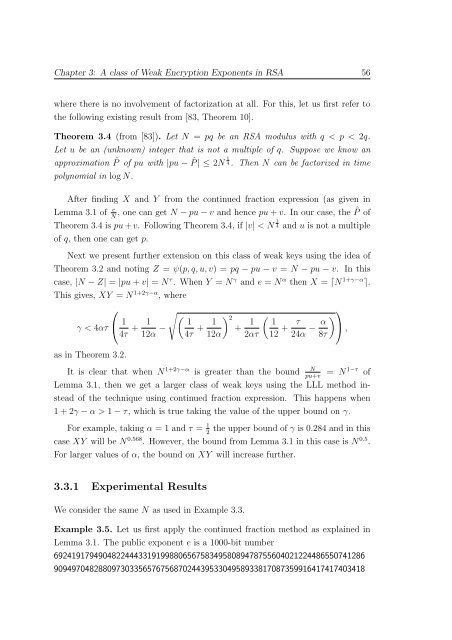Cryptanalysis of RSA Factorization - Library(ISI Kolkata) - Indian ...
Cryptanalysis of RSA Factorization - Library(ISI Kolkata) - Indian ...
Cryptanalysis of RSA Factorization - Library(ISI Kolkata) - Indian ...
You also want an ePaper? Increase the reach of your titles
YUMPU automatically turns print PDFs into web optimized ePapers that Google loves.
Chapter 3: A class <strong>of</strong> Weak Encryption Exponents in <strong>RSA</strong> 56<br />
where there is no involvement <strong>of</strong> factorization at all. For this, let us first refer to<br />
the following existing result from [83, Theorem 10].<br />
Theorem 3.4 (from [83]). Let N = pq be an <strong>RSA</strong> modulus with q < p < 2q.<br />
Let u be an (unknown) integer that is not a multiple <strong>of</strong> q. Suppose we know an<br />
approximation ˆP <strong>of</strong> pu with |pu − ˆP| ≤ 2N 1 4. Then N can be factorized in time<br />
polynomial in logN.<br />
After finding X and Y from the continued fraction expression (as given in<br />
Lemma 3.1 <strong>of</strong> e N , one can get N −pu−v and hence pu+v. In our case, the ˆP <strong>of</strong><br />
Theorem 3.4 is pu+v. Following Theorem 3.4, if |v| < N 1 4 and u is not a multiple<br />
<strong>of</strong> q, then one can get p.<br />
Next we present further extension on this class <strong>of</strong> weak keys using the idea <strong>of</strong><br />
Theorem 3.2 and noting Z = ψ(p,q,u,v) = pq − pu − v = N − pu − v. In this<br />
case, |N −Z| = |pu+v| = N τ . When Y = N γ and e = N α then X = ⌈N 1+γ−α ⌉.<br />
This gives, XY = N 1+2γ−α , where<br />
γ < 4ατ<br />
as in Theorem 3.2.<br />
⎛ √ (<br />
⎝ 1<br />
4τ + 1 1<br />
12α − 4τ + 1 ) 2<br />
+ 1<br />
12α 2ατ<br />
( 1<br />
12 + τ<br />
24α − α ) ⎞ ⎠,<br />
8τ<br />
It is clear that when N 1+2γ−α is greater than the bound<br />
N<br />
pu+v = N1−τ <strong>of</strong><br />
Lemma 3.1, then we get a larger class <strong>of</strong> weak keys using the LLL method instead<br />
<strong>of</strong> the technique using continued fraction expression. This happens when<br />
1+2γ −α > 1−τ, which is true taking the value <strong>of</strong> the upper bound on γ.<br />
For example, taking α = 1 and τ = 1 the upper bound <strong>of</strong> γ is 0.284 and in this<br />
2<br />
case XY will be N 0.568 . However, the bound from Lemma 3.1 in this case is N 0.5 .<br />
For larger values <strong>of</strong> α, the bound on XY will increase further.<br />
3.3.1 Experimental Results<br />
We consider the same N as used in Example 3.3.<br />
Example 3.5. Let us first apply the continued fraction method as explained in<br />
Lemma 3.1. The public exponent e is a 1000-bit number<br />
6924191794904822444331919988065675834958089478755604021224486550741286<br />
9094970482880973033565767568702443953304958933817087359916417417403418
















